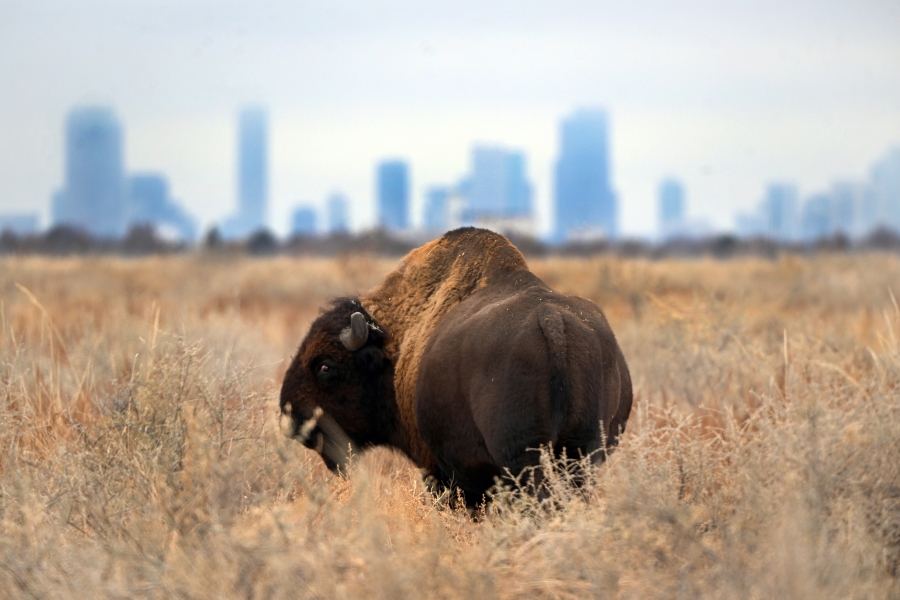DENVER — A growing herd of 250 bison, re-introduced at the Rocky Mountain Arsenal National Wildlife Refuge to help restore toxic wasteland to the native short-grass prairie, often descends through a floodplain to reach First Creek and cross to the northern half of the refuge.
But torrents of water spilling off the rapidly urbanizing parts of Denver and Aurora east of the 25-square-mile refuge have torn into the floodplain, carving a gully that blocks the bison from crossing the creek.
“This is a human-created challenge resulting from all the development,” biologist Sarah Metzer, the refuge’s supervisory ranger, said. “Bison are nimble animals but they’re going to have a hard time moving across this creek and getting up that other side.”
The deepening gully has become an obstacle for both the recovery of a genetically robust herd of bison and the broader mission of revitalizing this land, where the U.S. Army produced chemical weapons and the Shell Oil Co. produced the pesticide DDT.
“The bison won’t graze on the land across First Creek because now they have to go all the way around,” Metzer said. “That land is not going to get grazed. All the ecological benefits of having bison here are for naught.”
Federal wildlife biologists managing the refuge have a plan to reconstruct the floodplain, starting in January, with estimated costs ranging from $40 million to $61 million. They also hope to be ready to withstand additional pressures that will come with continued growth around the refuge and a warming climate.
It must be “restoration on steroids,” refuge manager David Lucas said.
Runoff increased gradually over three decades following the development east of metro Denver to create Denver International Airport, housing such as Denver’s Green Valley Ranch, Aurora’s $800 million Gaylord Rockies Resort and Convention Center, along with roads, shops, restaurants and parking lots. Development changed water flows as rain hit roofs, asphalt and concrete.
Historically, First Creek flowed intermittently, according to the U.S. Geological Survey. The floodplain reconstruction calls for re-contouring land and creating a curving creek, extending the length from 5.3 miles to 7.7 miles. The new floodplain then would be able to carry far more water toward the South Platte River.
Federal biologists have used bison, herbicides and prescribed fire to restore a native short-grass prairie that existed before 19th-century human settlement. The bison — a dozen were introduced in 2006 — have thrived, with some bulls weighing more than a ton. The toughest challenge for refuge managers, until now, has been crowd control as metro Denver residents and Colorado visitors flock to see the bison. Refuge visitation this past year exceeded 950,000.
But sustaining the bison, let alone allowing the herd to grow, requires access to sufficient prairie grazing habitat.
Lucas pointed to floodplain areas where runoff this year cut gullies six feet deeper. He recently began training to operate large yellow earth-moving machines himself.
“We have to increase the floodplain capacity. We are building resilience.”
The measurements from a USGS stream gauge near Pena Boulevard along First Creek show water flows increasing from “intermittent” around 1991 toward a steady flow of 4 to 8 cubic feet per second. This year, runoff surges pushed creek flows to nearly 800 cfs, a record, exceeding surges up to 420 cfs after northern Colorado’s 2013 floods.
To solve the problem, federal refuge managers are working with engineers from the Mile High Flood District, a taxpayer-supported agency charged with managing water runoff across a seven-county area where flows across 40 municipal boundaries create challenges.
“There definitely could be changes in the way land is developed when it comes to stormwater management,” said David Skuodas, the MHFD’s director of design, construction, and maintenance. “Imagine a neighborhood that looks completely different, with a lot more green space, a lot more open space.”



